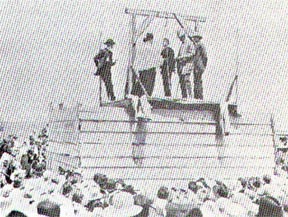 The last legal hanging
The last legal hangingin the Texas Panhandle
 The last legal hanging
The last legal hangingOriginal Story by Clayton Ferris
Written and submitted by Billie Harris Shaffer
G. R. Miller, of Childress, one day tired of his job, stole several sticks of dynamite, some fuses and a .38 revolver and set out to see what mischief he could get into. First he burglarized a house in Childress, then blew it up, and with the sound of the explosion still ringing in his ears, caught a freight train west.
First he got into a freight car with two youths, and shot one of them in the back and the other jumped out of the open doorway. Then Miller rolled the lifeless body of the first boy out the doorway into the sandy bed of the Red River.
When the train stopped at Memphis the brakeman put Miller off the train, then walked away and Miller got back on the train as it was pulling out. Unfortunately for them, he climbed into a car with two more youths, one of whom was playing a harmonica. He shot the harmonica player in the head and the second boy leaped out the doorway and caught a protuberance on the side of the door and climbed to the top of the train, then ran along the top until he got to the engine, where he told the engineer and the fireman what had happened.
The train stopped at Giles where the crew found the nearly dead boy in the boxcar and Miller nowhere to be found. They proceeded on to Hedley and notified a county deputy. The train then proceeded on to Clarendon where the injured boy was taken to a hotel where he died the next day.
Miller was caught the next day at Hedley, where he walked to a trainyard cookshack and asked for something to eat. He first stood trial at Childress for killing the first youth, and was convicted and sentenced to life imprisonment. He was taken to prison at Huntsville. Several months later he was brought back to Clarendon to stand trial for killing the second youth. He was again found guilty and this time was sentenced to death by hanging.
This sentence was carried out at 11 A.M. on
June 3, 1910. For some reason no death certificate was issued,
and although we can assume he was buried at Clarendon the location
of the grave is unknown.
Source: Photograph
"Panhandle Pilgrimage"
by Pauline Durrett Robertson and R. L. Robertson.
Published "Land
of Promise" a book by Virginia Browder.